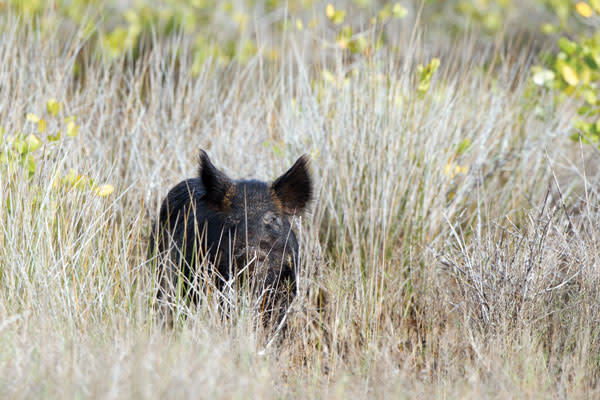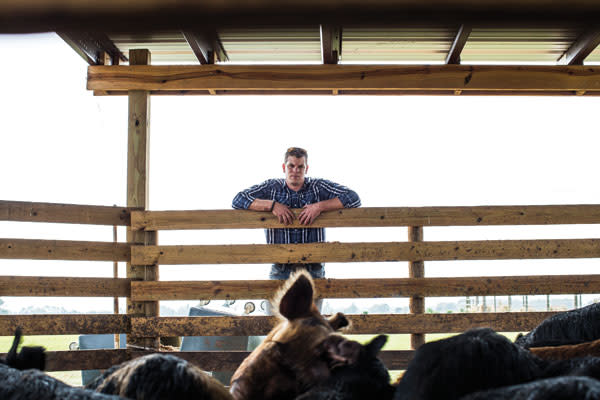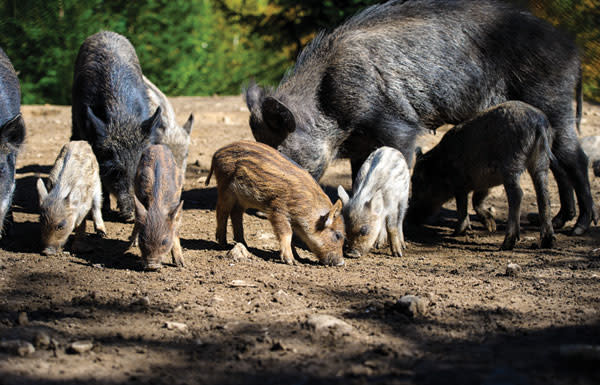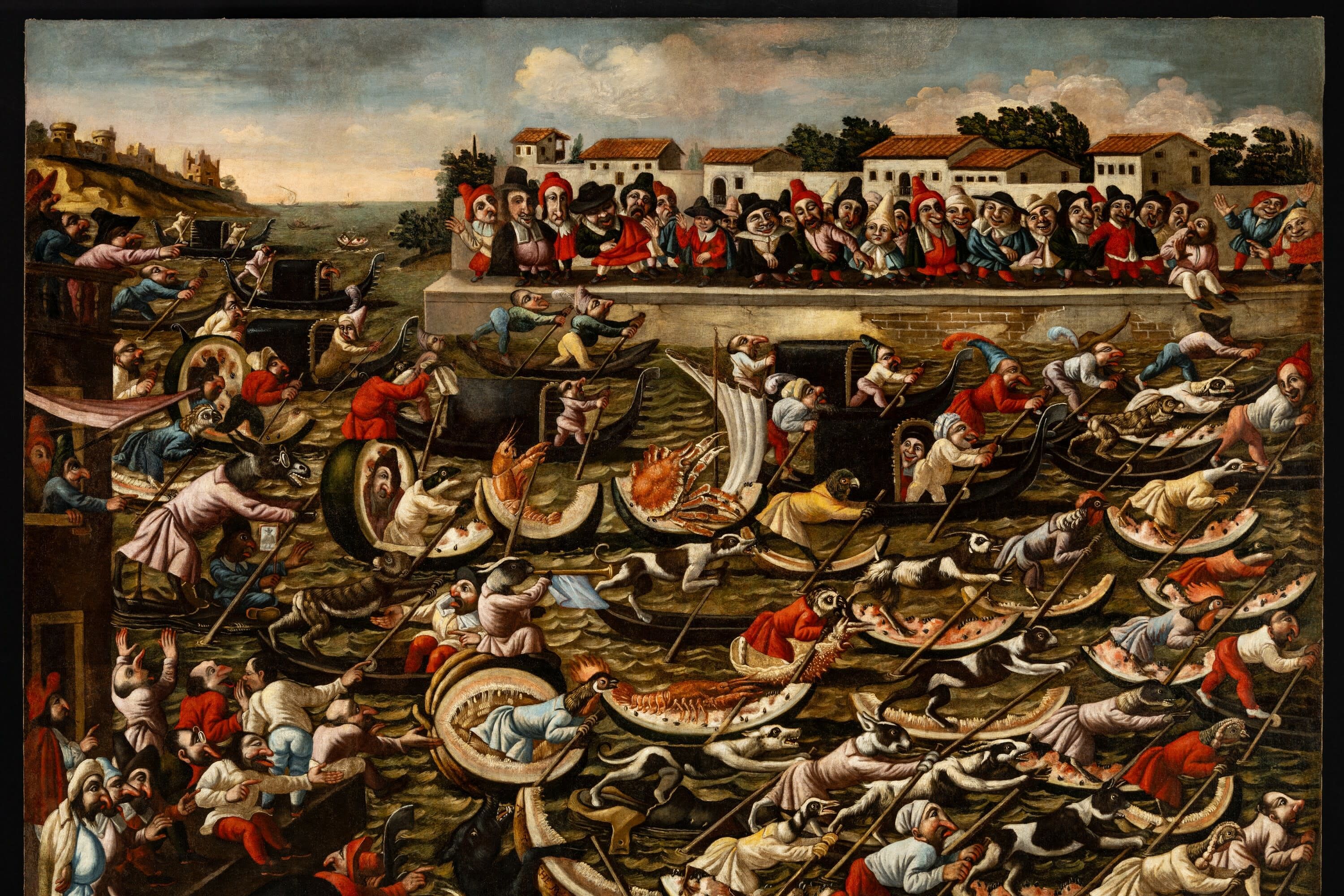Tracking Down Florida's Feral Hogs

It’s a crisp winter morning, and I’m banging down a dirt track at Keith Mann’s Three Suns Ranch in Punta Gorda, a 5,700-acre spread that’s home to his 2,500 buffalo, the largest herd of American bison in the state. The ranch is a family affair; Mann’s three young sons are fighting over a toy dinosaur behind us in his truck cab, and I’m already regretting not having brought my own kids along. All around us, woolly-headed buffalo are grazing lazily in the fields, but today we’re in search of something else: Florida’s wild hog, hybrid feral descendants of domesticated pigs first brought to nearby Charlotte Harbor by Hernando de Soto in 1539. Now estimated to number more than half a million by the Florida Wildlife Commission, the wild hog is the newest entrant on our area’s eco-conscious food scene.
For the past year, Mann has been paying local trappers to bring him live wild hogs. The animals are dispatched and dressed in his state-of-the-art mobile slaughterhouse, then a USDA inspector checks the meat, and it’s shipped to market. All of Mann’s wild hog buyers so far are out-of-state, save for Anna Maria Island’s Ed Chiles, a locally sourced food enthusiast who’s been experimenting with the meat in a variety of dishes at his Sandbar Restaurant. His chef, Ian Fairweather, features the wild pork in a Cuban sandwich, as well as in an appetizer with locally grown organic sauerkraut. Today, in keeping with the ideas of sustainability and knowing where our food is coming from, we’re going to bring a wild hog all the way from the woods to the table.
[caption id="attachment_43043" align="alignnone" width="600"]
In the driver’s seat beside me, Mann is a tall, sturdy, 35-year-old, who came down from his native Rhode Island after a 10-year military career, which included two years as a funeral caisson driver at Arlington Cemetery before three combat tours in Afghanistan as a Green Beret. Though he’s spent much of the past decade at war, there isn’t even a hint of those battles in him. He’s friendly, gentle with his boys, and has a keen mind for the past. Already in our conversation, he’s taken the history of Florida back to the fossil record and noted that his big piece of land is just a fragment of those old 60,000-or-more-acre cattle ranches that inheritance and sales keep breaking into ever smaller parcels.
“My wife and I are big into the Paleo Diet and CrossFit lifestyle,” Mann, a Bradenton resident, tells me as he drives us past a group of staring buffalo. “We came to Florida and were looking for responsibly raised, high-quality grass-fed meats and weren’t happy with what we saw. We’ve been doing buffalo since 2012; it was a leap of faith to do it ourselves. The problem with [today’s] pork, it’s so fatty—they’re pumped full of carbohydrates just to put on fat. These wild hogs got dropped on a continent 500 years ago and they’ve taken the place over. Nothing can stop them, and they’re much, much leaner.”
A scourge for landowners, golf courses, homeowners associations and conservation managers alike—Manatee County’s natural resources director Charlie Hunsicker estimates the hogs’ cost to the state is in the millions—wild hogs compete with native species for food, pollute water with their wallowing, and tear up the landscape like efficient plows in their eternal search for all things edible. Though Florida hunters have long been dining on this lean meat, Mann and Chiles are hoping to bring it to a wider audience. The success of Mann’s buffalo herd keeps his slaughterhouse running five days a week; and with a USDA inspector on hand to certify the hogs are free of brucellosis and other swine diseases, he can market them commercially. It’s the first operation of its kind in the state.
To eat a wild hog, first you have to catch one, and that requires somebody who knows how. It’s all part and parcel of the diversified mission of the local food movement. Not only might a commercial market for wild hogs help manage an acute environmental problem, but also paying local trappers to bring them in supports the area’s economy and traditional culture. Mann turns into the woods, and we soon pull into a foggy clearing. Tents are pitched here, and a dozen or so folks in camo stand around an open-pit fire and seem to eye us with suspicion. These are Mann’s hired Florida cowboys, camping with their families for the weekend. “I rely heavily on the generational knowledge these guys have in all things Florida and ranching,” Mann says. “There’s all this piled-up information in Florida Crackers.”
Mann, I suddenly understand, is a gentleman rancher; these are the dudes who get dirty. There are three generations of them here, Nelsons, Wingates and Skinners, most of them Arcadia-born and bred. Adam Nelson, 33, is in charge of Mann’s bison and has been herding livestock by horseback on this same land since he was a kid. His father, Willis, wrangles bison for Mann, as does another brother, Chad.
Nelson quickly warms up and tells us he’s set traps nearby for the hogs that roam these woods. His friend, Carl Skinner, has his “bay” and “catch” dogs with him in steel kennels in his pickup bed in case we spot any hogs in the field. These Florida Cracker cur dogs, as they’re called, are thick-bodied, working cattle dogs, long bred by Florida ranchers; Nelson explains that bay dogs bark and put a hog at bay, while catch dogs are braver and bite the hog to hold it while the hunters get behind it and grab its legs.
Nelson leads us out of camp, and not far away we come to the first of the traps. It’s a chest-high circle of heavy mesh fencing secured by sunken posts. It’s empty, with its plywood door still propped up, the trip wire running from it and across the small pen. There’s corn scattered inside for bait; the trap has no top so that deer and turkey can jump out, in keeping with game regulations. Wild hogs, considered an exotic species under Florida law, can be harvested at will on private land.
“I’ve had three or four at a time in a little trap like this,” Nelson tells me in his twangy, deeply Floridian English. “I’d feed the hogs inside this thing for two, three days, keep the door tied up. The next night, they all just flood in here because they’re used to eating in here.”
Nelson reaches in and plucks the tripwire and the door slams down. He says he sets the wire to the height of the size of hog he’d like to trap.
“The hogs have always been here,” he says, shaking his head. “We ate so much wild hog when I was growing up, I don’t hardly care to eat one anymore. Daddy’s always been a cowboy, [and wild meat] was 90 percent of what we ate. I didn’t realize I was living so healthy. [When Mann] started talking about selling wild hog, I said, ‘Who in the heck is gonna buy wild hog?’”
Mann nods. “The future is in the past,” he says.
“There are times you come down and there are hundreds and hundreds; everywhere you look you see hogs,” Nelson says. “And there’s times you might go two weeks and can’t find a hog. You got your big boar hogs, they move off and stay by themselves. A lot of times you see the others in packs [groups of sows and their young, called ‘sounders’]. They live off palmetto berries and acorns. When the acorns are down, they’ll turn this whole place over. We trap them and run dogs. I like running dogs better than I do trapping. It’s just more fun.”
He leads us along the forest edge and even from a distance, I can see the big black figures in the next trap along the way. When we’re on them, both hogs lie down on their haunches, watching us from where they’re stuck in the little pen, its side posts loose now because the hogs have been battling to get free through the night. We hang our elbows on the wire and look down at them. They’re quiet, and seem like giant rabbits, their ears so perked up and large, their hides thick, their long tails hairy and ending in curlicues. I can see their lean muscles expressed everywhere through their skin. These are two 150-pound sows, hardy animals, no industrial bacon on them, just the sort of hog that Nelson and Mann tell me are perfect for the table. Bigger, tusked boar hogs can be too tough for sensitive diners’ palates.
As we look at the hogs, Nelson begins a lively story.
“They’ll run into you, they’ll bite you,” he says, his eyes animated. “We once got a hog caught in the creek over there. My boy [Cutter, 6] has been with us ever since he was a little guy. When stuff gets bad, I just sling him in a tree. So I set him in the fork of that tree right there, I said, ‘I’ll be right back.’ We was down in that creek, just dogs, I got no gun on me [Nelson says he never hunts hogs with weapons] and the only thing we got now was a bay dog, we don’t even got a catch dog.
“We got in here and this old hog would run at us and we get to talking to that dog, saying, ‘Catch him, catch him!’ The hog run at us and run us off and finally that dog, we got him talked up into biting that hog. When he bit him, we caught him [the hog]. I catch him by the hind legs, roll him over on his side. You get on him with your knees and tie his legs up. I say, ‘We’ll just turn him loose because the creek’s high.’ I shove him off and I turned around and went up the creek bank. Well, he spun around and jumped and pinched me right there on my butt cheek and I squealed like a little kid. My boy’s sitting in the tree and I’m squealing, running around the tree and he says, ‘Hey, Dad! Why don’t ya climb the tree with me?’”
Another day, he tells us, he and Cutter, who was 3 or 4 at the time, were surrounded by hogs that started to charge them. “Reckon it’s time to put me in a tree!” Cutter called out.
Everybody’s laughing, and Nelson and another cowboy lower lasso nooses into the pen. The hogs are quickly trussed, carried out and put in the bed of a truck without so much as a squeal. I ask Nelson what his favorite way to eat wild hog is and he tells me, “We usually buy beer and start a campfire. We wrap it up in some tinfoil and smoke it. Then I cut it up and flour it and grease it and fry it. Matter of fact, Keith last night for his first time ate fried ribs.”
Mann nods and says, “That’s probably the best hog rib I’ve ever had.”
“I like the woods,” Nelson says. “My kids have never done the stuff [on the land] I’ve done. It’s not here no more. There was the land and the country and work, and it ain’t like it used to be. I used to work on ranches with 90,000 acres down here. Those ranches are all busted up now because somebody died and they split it up. My kids will never get to go [across the land] like we did when we was little, never.”
I’m feeling nostalgic for Old Florida and the stories Nelson can tell so easily. Mann has been talking about the housing developments steadily creeping this way from the coast, and I understand that in doing this story about wild hogs, what I’ve really learned about is Florida.
As we head across the ranch in a convoy of trucks, we spot a wild hog in the nearby field. We all hop out, and Carl Skinner releases two of his dogs, Jake and Dixie, from their kennels. They explode toward the hog before it even has a chance to turn and run. A dozen of us—adults, kids—race after. Jake and Dixie are barking, they’ve got the hog bayed and turned to them, and just like that, one of the cowboys, Jonathan Wingate, grabs the hog’s hind legs and pins it under his knees. It happens too fast to take any notes, something skillful and brave and handed down from the past.
A few days later I return to the ranch and see the hogs dispatched and washed under the watchful eye of Joey Long, a 15-year meat industry veteran who runs Mann’s slaughterhouse. Skinned, dressed and hanging in the walk-in cooler, the hogs are pretty, lean meat, all bearing the blue-ink USDA stamp. “This is the first time I’ve ever seen anybody in Florida doing what we do here,” Long says. “This is a very good animal; they all look extremely healthy and there’s hardly any fat content. It’s a trend. It really started probably two years ago with the grass-fed beef, all this organic meat. People want to know what’s been fed to their animals. The market is changing—it’s going this way.”
I take home a four-and-a-half pound whole ham, and, on the advice of the Sandbar’s chef Fairweather, skip the marinade and simply season the meat with sea salt, pepper, olive oil and garlic; chop up some potatoes and celery; and cover and bake everything at low heat for seven-and-a-half hours. What comes out of the oven is a succulent dark meat that shreds off the bone like pulled pork. It’s lean and delicious and is devoured by my family in just a few days. The only thing left to figure out now is when I’ll next be down with the Florida cowboys on the ranch, hunting wild hogs by hand and slinging my kids into the trees.

Hog Heritage
The feral hogs that came here from Spain could be part of a growing local industry.
To try wild hog yourself, head up to Anna Maria Island’s Sandbar Restaurant, where owner Ed Chiles and chef Ian Fairweather have been featuring the lean, dark meat in various dishes alongside their regular menu. Chiles, son of the late Gov. Lawton Chiles and cousin of North Carolina United States Sen. Kay Hagan, is a self-described multigeneration Florida Cracker from Lakeland who used to hunt wild hogs on horseback and vacationed on Anna Maria as a child. He bought the waterfront Sandbar—where he’d had his first beer years earlier as a teen—in 1979, and now his Chiles Restaurant Group also owns Mar Vista Dockside Restaurant & Pub on Longboat Key and the Beachhouse Restaurant in Bradenton Beach. Chiles has become a leader in the local food movement, and with Cortez’s Seth Cripes, co-founded the Anna Maria Fish Company, which produces bottarga, cured roe from local mullet, considered a culinary delicacy. In 2013, The New York Times featured the Anna Maria Fish Company and its roe, which is now shipped around the world.
“I’ve had the hog idea for 20 years,” says Chiles. “Here’s the wild pig that’s a terrible environmental problem. But it’s also a fabulous opportunity. Where do the best pigs in the world come from? Spain. The best pig in Spain is the Iberico de Bellota. And bellota means ‘acorn.’ And where do our pigs come from? Spain, with a little [Eurasian boar in its genetic mix]. What do our pigs eat? Acorns. It makes the meat nutty and natural and rich, and acorn is a good oil for you.”
But as promising as the idea seemed, Chiles couldn’t move forward, because the meat could not be sold unless the hogs were processed in a facility providing USDA inspection. When Chiles heard that Keith Mann wanted to sell wild hogs to the commercial market and had a USDA inspector in place, he says, he went to Punta Gorda and said, “Keith, you’re not crazy, and I’m going to make you famous.”
Wild hog is not only delicious, says Chiles; it’s another building block in a uniquely Southwest Florida industry. “If we continue to build on the example of bottarga, we can create a business that will honor our heritage, brand our area, speak volumes about our values and character, and be good for our environment,” he says.
Sandbar Restaurant
100 Spring Ave.
Anna Maria Island
(941) 778-0444
Rancher Keith Mann sells wild hog and grass-fed bison meat at his Three Suns Ranch on-site shop, and also offers weekend tours by reservation.
Three Suns Ranch
2351 S.R. 31
Punta Gorda, Fla.
Wednesday 2 p.m.-6 p.m.
Saturday 10 a.m.-2 p.m.
(941) 639-7070
Contributing editor and novelist Tony D’Souza has won several awards for his work for this magazine, including a Florida Magazine Association first place for Best In-Depth Reporting in 2013; he was also named a finalist for Best Essay from the City and Regional Magazine Association in 2014. He wrote “Going Nowhere,” in the January issue.



